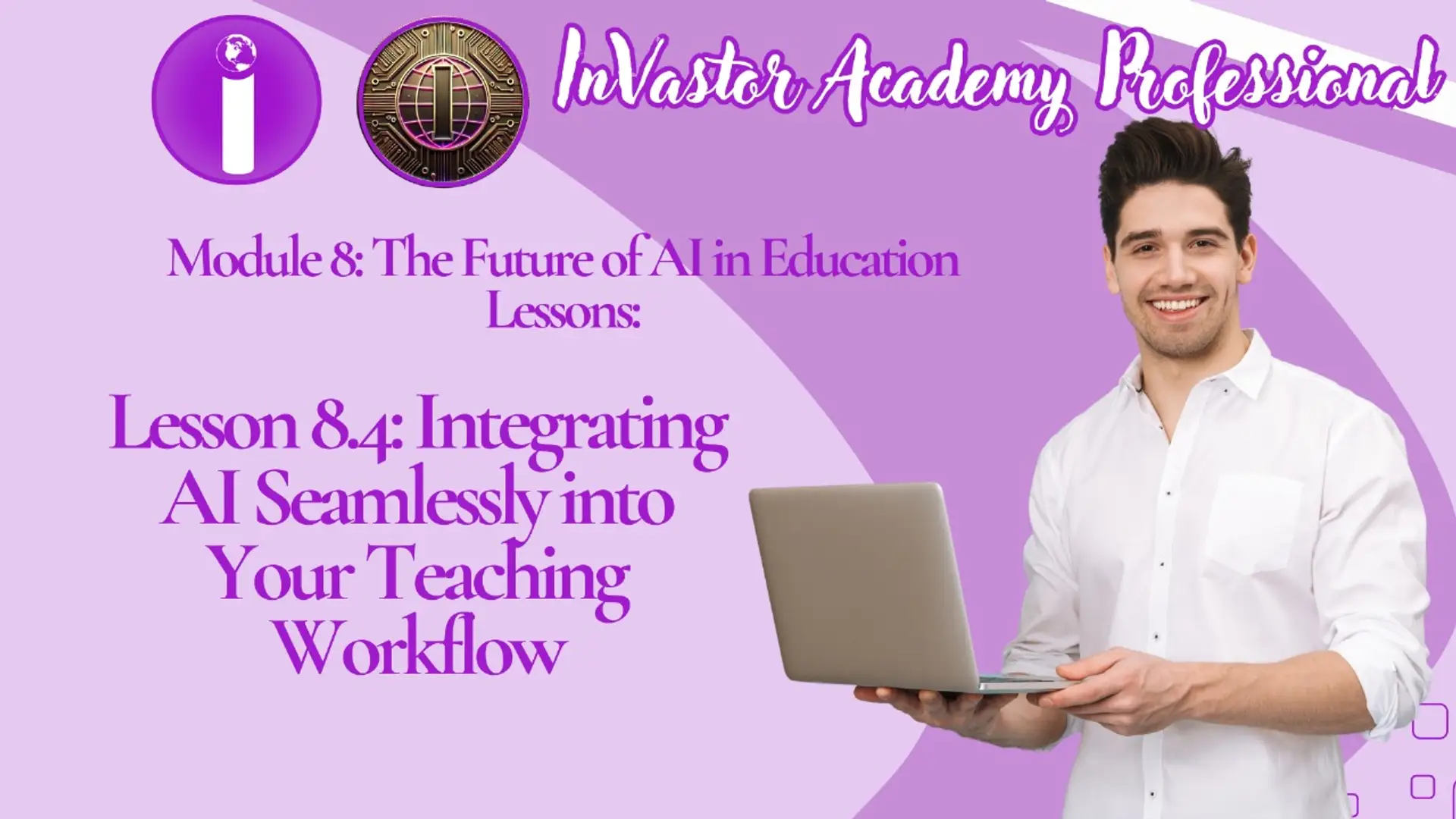

Module 8: The Future of AI in Education Lesson 8.4 — Integrating AI Seamlessly into Your Teaching Workflow
Module 8: The Future of AI in Education
Lesson 8.4 — Integrating AI Seamlessly into Your Teaching Workflow
Learning Objectives
By the end of this lesson, educators will be able to:
- Identify practical ways to integrate AI tools into everyday teaching tasks.
- Use AI to enhance efficiency, creativity, and student engagement without compromising ethics or data privacy.
- Differentiate between automation and authentic human instruction.
- Develop a balanced workflow where AI supports — not replaces — educator expertise.
- Evaluate AI tools for instructional value, privacy compliance, and accessibility.
1. What Does “Seamless Integration” Mean?
Seamless integration means embedding AI tools naturally into your teaching routine — not as an add-on or gimmick, but as a strategic support system.
When AI is integrated effectively:
- Teachers save time on repetitive tasks.
- Students receive more personalized learning experiences.
- Classrooms become more adaptive, inclusive, and engaging.
Key Principle:
AI should amplify good teaching — never replace it.
2. Areas Where AI Can Enhance Teacher Workflows
AI tools can assist at nearly every stage of the teaching process.
3. Steps to Integrate AI into Your Workflow
1.Start Small:
- Choose one repetitive task (like drafting quizzes or lesson plans) to test AI support.
2.Use District-Approved Tools:
- Always ensure compliance with FERPA, COPPA, and school policies.
3.Verify Outputs:
- Review AI-generated materials for accuracy, bias, and alignment with standards.
4.Maintain Human Oversight:
- The teacher remains the final decision-maker. AI suggestions should never be used “as-is” without review.
5.Reflect and Refine:
- Record what worked, what didn’t, and adjust your approach as AI evolves.
6.Share and Collaborate:
- Exchange experiences and best practices with colleagues in your department or PLCs.
4. Ethical and Professional Considerations
Even when AI saves time, educators must stay mindful of:
- Data Privacy: Never upload student-identifiable information into public AI systems.
- Bias and Accuracy: Cross-check AI-generated content for stereotypes, factual errors, or cultural insensitivity.
- Transparency: Inform students when AI tools are used to create content or feedback.
- Equity: Ensure all students benefit equally from AI-enhanced instruction.
- Intellectual Property: Cite and attribute AI-generated materials appropriately.
Remember:
Efficiency should never come at the expense of ethics.
5. Practical Classroom Integration Scenarios
Scenario 1: Lesson Design
You use an AI planner to outline a week-long science unit on ecosystems.
AI generates lesson objectives and sample activities.
✅ You review, edit, and adapt them to fit state standards and student needs.
Scenario 2: Writing Feedback
Students submit essays digitally.
You use an AI assistant to highlight common grammar and structure issues.
✅ You personally review and add individualized feedback for learning depth.
Scenario 3: Accessibility Support
A student needs reading support.
AI adjusts text complexity or translates into another language.
✅ You verify comprehension and provide follow-up instruction.
Scenario 4: Family Communication
You ask AI to draft a progress letter to parents.
✅ You proofread, personalize, and send through approved school channels.
6. Building Long-Term AI Workflow Habits
To make AI integration sustainable:
- Create a Personal AI Toolkit: Keep a shortlist of vetted, compliant AI tools.
- Schedule “AI Reflection Time” monthly to explore new tools responsibly.
- Document AI Use: Keep brief notes on how AI supported your tasks — useful for evaluation and PD.
- Stay Ethical: Review privacy agreements regularly.
- Model Responsible Use: Teach students how to critically engage with AI.
7. Supplementary Resources
- Top 5 AI Tools for Teachers in 2025
- How Can You Evaluate AI SaaS For Data Privacy Compliance? - AI SaaS Software Explained
- OneConfirm - Seamlessly Integrated
Lesson 8.4 Quiz — Integrating AI Seamlessly into Your Teaching Workflow
Complete the quiz to check your understanding of policy development and ethical frameworks.
You must score at least 70% to pass.
Conclusion
Seamless AI integration is about balance — blending the efficiency of technology with the empathy and creativity of great teaching.
Effective educators:
- Use AI to streamline, not substitute.
- Stay mindful of ethics, privacy, and transparency.
- Continuously refine their workflows as technology evolves.
AI doesn’t make teachers less important — it empowers them to focus on what matters most: human connection, critical thinking, and meaningful learning.
Next and Previous Lesson
End of Module 8: The Future of AI in Education
Previous Lesson: 8.3 — Continuous Learning & AI Literacy for Educators
AI for Educators: Personalized Learning & Content Creation
Related Posts
© 2025 Invastor. All Rights Reserved


User Comments